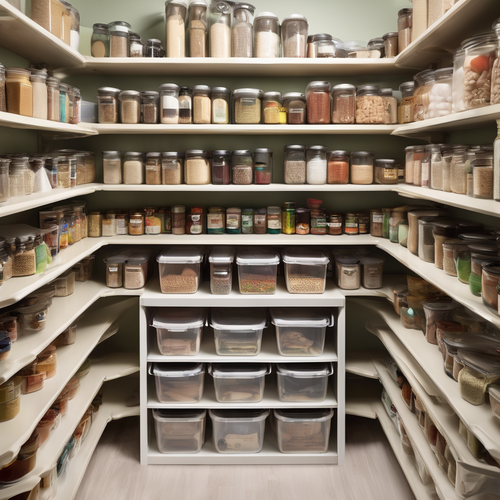
Storing Food to Last: Techniques for a Fresher Pantry
In the vast ecosystem of our kitchens, food stands like a vibrant yet volatile piece of art, colorful and inviting—until it turns into a moldy masterpiece far too soon. With the alarming rates of food waste coupled with skyrocketing grocery bills, knowing how to store food properly becomes not only a matter of preserving delights but also of saving cents. After all, what’s the difference between a perfectly ripened avocado turning into mush and a well-organized fridge? Only the knowledge of the art of lasting preservation. 🥑
Understanding the Basics: Why Proper Storage Matters
Picture this: you buy a bouquet so fresh it could outlive a rom-com villain, yet it wilts before you can whisk it into your dinner plans. Often, the culprits are improper storage methods, which transform potential culinary creations into regrettable compost. Food, much like dreams, requires the right environment to thrive.
Food storage isn’t merely practical; it’s a delicate dance of chemistry and temperature control. The nuances of oxygen, humidity, and temperature fluctuations warrant expertise akin to that of a seasoned alchemist. By leveraging informed strategies, you can extend the life of your food significantly, enjoying its freshness while keeping waste at bay.
Refrigeration Revelations: Cold Hard Facts
When it comes to keeping food fresher longer, the fridge is your best ally, yet it can also be an enemy in disguise if not used wisely. Consider the space in your refrigerator as a microclimate where some foods thrive while others wither:
- Top Shelves: Ideal for drinks and ready-to-eat foods. Think of it as the VIP section where salads and leftovers can chill out without a care in the world.
- Middle Shelves: Perfect for dairy products, where the temperature is consistently cool—much like a spa day for your yogurt and cheese.
- Bottom Shelves: The coldest part, ideal for raw meat and fish. It’s akin to the basement of an old manor, often dark, and home to the most coveted treasures.
- Crisper Drawers: Designed for fruits and vegetables—but they can be a double-edged sword. High humidity benefits greens, while low humidity favors fruit. Contrasting desires, much like two friends trying to agree on a movie!
“You don’t want your tomatoes hugging your lettuce like old friends—they need their space!” adds culinary expert, Chef Marco Duval. 🍅
Here’s How to Store it Right: Hacks and Tips
Fresh Herbs: Treat them like cut flowers. Store herb sprigs upright in jars with water (like a herb bouquet), or wrap them in a damp paper towel and place them in a bag. They’ll last longer, reminding you of spring every time you reach for them. 🌿
Avocados: Ripen at room temperature, then refrigerate as soon as they’re ripe to slow the process—like a diva insisting on staying in their prime.
Bread: Keep it wrapped in a paper bag to balance moisture while preventing it from hardening into a brick. For long-term storage, slice and freeze. It’ll be thawed and ready to toast before you know it! 🍞
Cheese: Paradoxically, cheese prefers to breathe a bit. Store it in parchment or wax paper before wrapping it loosely in plastic. It’s all about giving it a slightly restrained life.
The Pantry Paradox: Dry Goods Storage
Venture beyond the fridge into that magical land we call the pantry, where jars and boxes line up like soldiers waiting for command. However, dry goods are not merely decoration. They require thoughtful organization:
- Airtight Containers: Invest in some. Not only do they keep pests out, but they maintain airflow, prolonging the shelf life of treasures like pasta, rice, and legumes.
- Dark and Cool is Key: Store grains and cereals in dark spots; sunlight is their nemesis. Your pantry is like a subtle cave—who doesn’t want their food to hibernate in peace?
Freezing: The Last Frontier of Freshness
Embrace freezing not as a lifeline for neglected leftovers, but as a time machine for your ingredients. Foods can alter their texture when frozen improperly, yet proper practices preserve not just their essence, but their integrity. Here’s your freeze-frame guide:
- Wrap it Right: Squeeze excess air from bags and consider vacuum sealing. No one wants freezer burn ruining their culinary memories—like a foggy photograph of a cherished day.
- Label, Label, Label: Mark down contents and dates. It’s like a diary for your food, reminiscing about its journey before it makes its comeback in your kitchen.
The Circular Economy of Food Waste
In an era where waste reduction is not just trendy but essential, consider the circular path of food around your kitchen. Compost what you can; it’s like giving back to the Earth, contrasting the surplus of waste with the rejuvenation of soil. Your discarded scraps become a resource for growth—a striking antithesis of negligence turned intention.
If you’ve taken out more than you can consume, share with friends, neighbors, or even explore local food banks. The act transforms you from a mere consumer into a community member, essential for fostering togetherness. This sense of unity, in turn, nourishes the hearts of others while giving your food a second life.
Awareness: The First Ingredient
Ultimately, mastering food storage invites a nuanced blend of science, creativity, and mindfulness. With the right strategies, you can luxuriate in culinary adventures rather than mourn the loss of your last avocado. Why let a perfectly good piece of produce wilt unceremoniously on your counter when you can store it and imbibe in its deliciousness for weeks to come?
So, as you navigate the intricacies of your kitchen, ask yourself: how can I make every bite count? The art of food storage isn’t merely about longevity—it’s about celebrating the journey from farm to table and embracing every moment of that experience. Bon appétit! 🍽️
